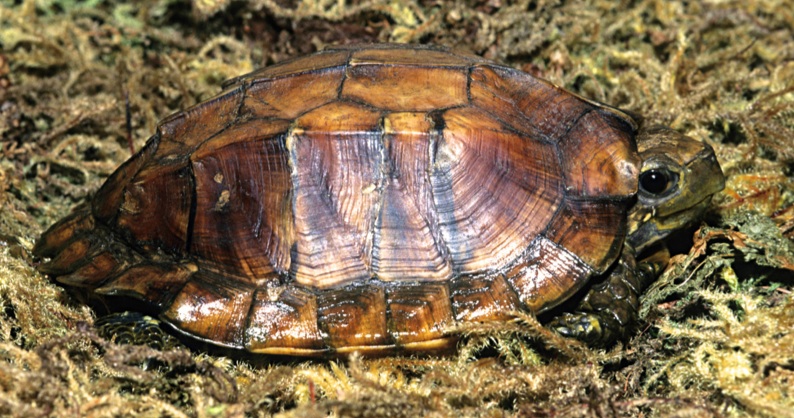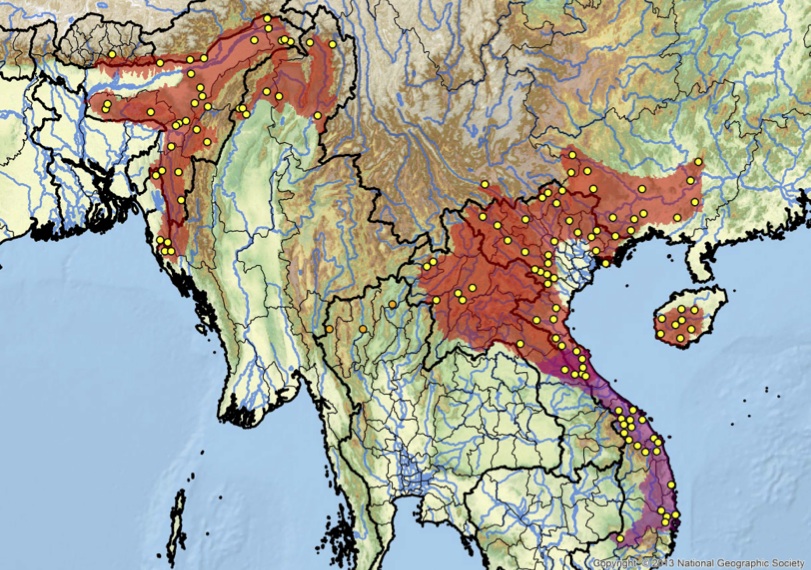Cuora mouhotii, 099
Cuora mouhotii (Gray 1862) –
Keeled Box Turtle
Indraneil Das1, Timothy E.M. McCormack2,
Peter Paul van Dijk3,4, Ha V. Hoang2, and Richard P.J.H. Struijk5
1Institute of Biodiversity and Environmental Conservation, Universiti Malaysia Sarawak,
94300 Kota Samarahan, Sarawak, Malaysia [[email protected]];
2Asian Turtle Program (ATP) of Indo-Myanmar Conservation (IMC), Room 1806, C14 Bac Ha Building, To Huu Road, Tu Liem District, Hanoi, Vietnam [[email protected], [email protected]];
3Global Wildlife Conservation, PO Box 129, Austin, Texas 78767 USA [[email protected]];
4Turtle Conservancy, 49 Bleecker Street, New York, New York 10012 USA;
5RAVON Foundation (Reptile, Amphibian & Fish Conservation Netherlands), Natuurplaza,
Toernooiveld 1, 6523 ED Nijmegen, Netherlands [[email protected]]
Summary. – The Keeled Box Turtle, Cuora mouhotii (Family Geoemydidae), is a small (carapace length up to ca. 250 mm), once poorly-known terrestrial species. Recent extensive research on the species in its natural habitat in northern Vietnam and Hainan, China, has significantly increased available knowledge of the species. Cuora mouhotii is a highly terrestrial turtle from the mesic forests of Southeast Asia. Two subspecies have been described, and intergradient populations are known. Relatively widespread, it is apparently abundant nowhere. Omnivorous, at least in captivity, the species is highly carnivorous in the wild but will also take fruit. Clutch size ranges from 1–9 eggs, with egg dimensions ca. 41 x 26 mm; incubation period in captivity varies from 82 to 120 days. Major threats to the species are loss of forest habitat from logging and commercial trade for Traditional Chinese Medicine and food. To a lesser extent capture for local consumption and both national and international pet trade are factors threatening this species.
Distribution. – Bangladesh, Bhutan, China, India, Laos, Myanmar, Thailand (?), Vietnam. Ranges across Southeast Asia from Bhutan and northeastern India in the west to central Vietnam and southern China in the east, possibly discontinuous in Thailand.
Synonymy. – Cyclemys mouhotii Gray 1862, Pyxidea mouhotii, Emys mouhotii, Geoemyda mouhotii, Cuora mouhotii.
Subspecies. – Two currently recognized: Cuora mouhotii mouhotii (Mouhot’s Keeled Box Turtle; southeastern China, northern Laos, northern Vietnam, possibly northern Thailand) (synonymy: Pyxidea mouhotii mouhotii) and Cuora mouhotii obsti (Obst’s Keeled Box Turtle; central and southern Vietnam) (synonymy: Pyxidea mouhotii obsti Fritz, Andreas and Lehr 1998). Records from Bangladesh, Bhutan, northeastern India, and Myanmar may refer to an undescribed lineage.
Status. – IUCN 2016 Red List: Endangered (EN A1d+2d, assessed 2000); TFTSG Draft Red List: Critically Endangered (CR, assessed 2011); CITES: Appendix II (as Cuora spp.).
Citation:
Das, I., McCormack, T.E.M., van Dijk, P.P., Hoang, H.V., and Struijk, R.P.J.H. 2016. Cuora mouhotii (Gray 1862) – Keeled Box Turtle. In: Rhodin, A.G.J., Iverson, J.B., van Dijk, P.P., Saumure, R.A., Buhlmann, K.A., Pritchard, P.C.H., and Mittermeier, R.A. (Eds.). Conservation Biology of Freshwater Turtles and Tortoises: A Compilation Project of the IUCN/SSC Tortoise and Freshwater Turtle Specialist Group. Chelonian Research Monographs 5(9):099.1–12. [doi:10.3854/crm.5.099.mouhotii.v1.2016; //iucn-tftsg.org/cbftt/]
(Adobe Acrobat 6.0 or later required)

Subadult Cuora mouhotii from southeastern China.
Photo by Indraneil Das.
Distribution:

Distribution of Cuora mouhotii in Southeast Asia. Yellow dots = museum and literature occurrence records of native populations based on Iverson (1992), plus more recent and authors’ data; orange dots = probable market specimens. Red shading = projected historic distribution of C. m. mouhotii (western populations may represent a distinct lineage), purple shading = C. m. obsti, overlap = intergrades. Distributions based on GIS-defined level 10 HUCs (hydrologic unit compartments) constructed around verified localities and then adding HUCs that connect known point localities in the same watershed or physiographic region, and similar habitats and elevations as verified HUCs (Buhlmann et al. 2009; TTWG 2014), and adjusted based on authors’ subsequent data.








